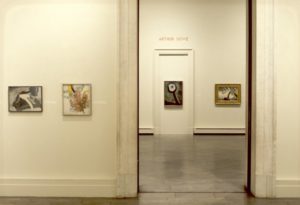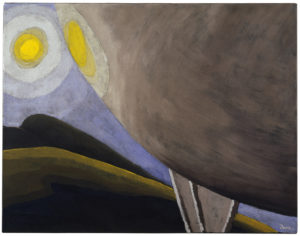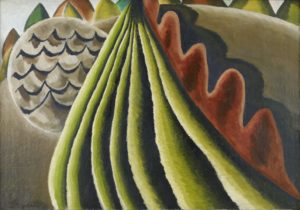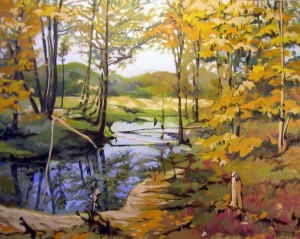Dear Artist,
On the internet, there are three kinds of artwork images: Photography, which has to be printed or projected to exist materially and so can be done by anyone if it’s of high enough resolution; painting, drawing and other 2D forms meant for reproduction — which carry the same vulnerability; and all other original artwork never intended for reproduction. The reason I bring this up is that I notice many well-meaning painters applying watermarks to their images and assume it’s because they worry that it will be reproduced for profit without their permission. While this does happen as well as outright forgeries — (my dad wrote to you about this, here, ) — watermarking also comes with a more immediate and problematic effect; it distracts from your image and changes the message, context and viewing experience of your work. This is especially important to understand right now, when almost everyone who is looking at art is doing it online.
At the risk of sounding like a broken record, in 2020 two art forms are attached to every work of art: the first is your art — that thing you made that’s sitting in your studio or in a gallery. The second is the image of that thing, an image that has to reach through the screen and incite a response in a person who once was a gallery goer — now, a scroller. This scroller is looking at hundreds, perhaps thousands of images carefully constructed as advertising, (or advertising carefully constructed as images) and discriminating on meaning, authenticity, context and the value of that thing, in a matter of seconds. Her heart and brain ask, “Is it art? Is it real? Is it precious? Does it live in the digital world or the physical world?”
If this argument feels weak in the face of forgeries, unauthorized prints, general borrowing of your images for other people’s online content or just copying, consider that if a watermark can be added to your image, it can also be removed, in which case you’ve gone to the trouble of laying something unsightly on top of an image that should have been executed with extreme care — just to try to prevent the unpreventable. You need only to google “watermark remover” to know what I’m talking about. Instead, try to focus on what you can control, including the quality and authenticity of your artwork — both versions — the real one and the image of it you post online.
Sincerely,
Sara
PS: “A lotta cats copy the Mona Lisa, but people still line up to see the original.” (Louis Armstrong)
Esoterica: The antidote and the attraction to copying is branding — it’s why the biggest names sign their names big, plus take other creative measures to show they’re the real deal. And while being a Big Time Charlie may not be your style, it’s a worthy pursuit to pay attention to refining the originality of your ideas and presenting your work in a way that signifies the uniqueness of your process, environment and personality. I may be delusional in saying this, but I’m beginning to feel like the days of presenting only cropped, evenly-lit images of paintings could be numbered. Auction houses, museums, artists and galleries now regularly employ in situ shots, framing, shadows and light raking, interesting installation, walls and floors, furniture and even dogs disclosing scale and light conditions — all enriching an otherwise impersonal experience of looking at art online. It may even make it harder to make copies.

Installation view of Arthur Dove at the Albright-Knox Art Gallery, 1975.
Albright-Knox Art Gallery Digital Assets Collection and Archives photo.
Have you considered a Premium Artist Listing? With each letter, an artist is featured at the bottom of this page. The Premium Artist Listings are a means of connecting artist subscribers through their work. Proceeds from each listing contribute to the production of The Painter’s Keys.
“I would like to make something that is real in itself, that does not remind anyone of any other things, and that does not have to be explained — like the letter A, for instance.” (Arthur Dove)
Featured Artist
My statement is pretty short. I love all kinds of paintings and I think Robert Genn is Canada’s finest painter. A great feature of his work are his designs — so beautifully conceived.







10 Comments
Such a great post!!! Keeping it real. Share, don’t fear.
Really good post and one that I happen to whole heartedly agree with. Thanks!
I try to remember to make my online art small dimensions at 72 ppi and to have my web address embedded on the bottom opposite the signature. It will not keep anyone from stealing if they are determined, but the honest people know where to reach me.
Yes, I have felt for a long time that photos just taken in situ are relevant. They make a case for what you have done. Thank you for this post. It is important.
I am curious Sara if you distinguish between a copyright and a watermark. I have neglected for the most part to put any kind of copyright at the bottom of my mixed media print work and lately I started doing so. My own experience in terms of attempting to sell art online is that if as someone above says it is only “small” no one can really see what it looks like and it’s very risky to buy some thing that you can’t tell what it looks like online. So I have high-quality images online and yes I think they would be stealable for the unscrupulous. My understanding is that if you have no copyright notice on your work it makes it harder to go after somebody in court. As a designer I was involved in a copyright lawsuit and because my copyright was not printed on the work I could only get a fraction of the damages I could have if I had had a copyright notice. That was of course a long time ago and maybe the laws have changed.
Printing your copyright on the image is not what allows you to sue for monetary damages. In order to ask for financial remuneration, you have to actually register your copyright with the copyright office. Any work that is fixed in a tangible form is automatically copyrighted to the creator and you can still sue for a cease and desist order even without registering it.
I am one of the artists that Robert contacted some years ago when he found some of my images, copied from my web site, being sold by a Chinese company. I had safeguarded by including a date and copyright symbol beside my signature, and ensuring only low-res images were on my web site. These did not deter the pirates although they did stop selling the, (at least on the original site) after I contacted the company to express my displeasure.
Some theft seems unavoidable–my technical books became freely available on the internet (but printing them out would cost about as much as buying the ‘real’ one) and I decided it was not worth the effort. In the textbook field the secret is to have a ‘new edition’ come out every few years. As far as art, I would go with posting low-resolution images so the quality of any illegal reproduction would be inferior. And if someone is that poor (or cheap), I would bless them with their good taste in appreciating my work.
Unfortunately, it’s not about them being “poor”. Most often it is not a single individual who is stealing the images, but a person working for a company based “in another country” that then prints the images on cards, posters, or even fine art reproductions. I definitely do not agree with posting large, high-res images of your work online without some kind of protection. Large, very low opacity wording works well. It is barely visible online and if downloaded would be an absolute bear (if not impossible, depending on the artwork) to remove before being used illegally. Online thieves, just like their real life counterparts, are out for the easy take. If anything makes that difficult they move along to the next mark.
This piece beautifully captures the dilemma faced by artists sharing their work online: the desire to protect versus the need to connect. The argument against watermarking is compelling—not just for aesthetic reasons, but for the deeper truth that every nelnet student loans image now carries two lives: the physical artwork and its digital echo. In a world of fleeting impressions, preserving authenticity and emotional resonance matters more than ever. Thank you for this thoughtful reminder.